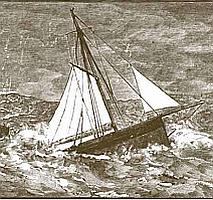 Here is another old favorite, a companion repost to yesterday’s repost of “The Unsinkable Hugh Williams – Truth Behind the Legend?”
Here is another old favorite, a companion repost to yesterday’s repost of “The Unsinkable Hugh Williams – Truth Behind the Legend?”
We recently posted in response to a video, “The Strangest Coincidence Ever Recorded?.” It recounted how three men named Hugh Williams were each the only survivors of shipwrecks in the treacherousness Menai Straits off North Wales. More remarkably, two of the Hugh Williams escaped from shipwrecks on the same day, December 5th separated by over a hundred years. The video claimed that all three Hugh Williams’ ships sank on December 5th, but that was not the case. And Hugh Williams is a very common name in North Wales, so while it is a remarkable coincidence, it doesn’t quite rank as the “strangest ever recorded.”
On the topic of nautical coincidences, Chris Quigley at the Quigley’s Cabinet blog, mentioned the Mignonette coincidence. All that we can say is, Hugh Williams meet Richard Parker. The case of Richard Parker and the Mignonette does indeed involve coincidence but the story remains compelling because it raises issues of morality that are very tricky to address, even to this day.
Richard Parker was a 17 year old cabin boy on the English yacht Mignonette in 1884. While in the South Atlantic, the Mignonette sank, leaving Parker and three others in a lifeboat with little food or water. The three ultimately killed and ate the cabin boy. The three were rescued after 24 days by the German sailing barque Montezuma, named fittingly enough after the Aztec king who practiced ritual cannibalism. The case caused a great uproar in Victorian Britain. The men were charged with murder and were found guilty. (The sentences were later reduced to 6 months of hard labor.) Most importantly, their trial, R v Dudley and Stephens, established a legal precedent in common law around the world, that necessity is no defense to a charge of murder.
OK, so what does this have to do with coincidence? The coincidence arises with Edgar Allen Poe’s only full-length novel, The Narrative of Arthur Gordon Pym of Nantucket, written in 1838 in which a whaling ship sinks, one of the survivors is named Richard Parker and is eaten by the other survivors. Some claim that Poe’s novel, written fifty years before, foretold of poor Richard Parker’s end. The only problem is, that while both the fiction and the history involved a ship and cannibalism, the rest of the details did not track so closely. Poe’s Parker was a mutineer, not a cabin boy and the events took place on the hull of an overturned ship and not a lifeboat. Poe may have modeled his character on another mutineer named Richard Parker who lead the mutiny at the Noire in 1797 and was subsequently hanged by the Royal Navy.
In Poe’s novel, the ship’s dog was named Tiger. In 2001, Yann Martel published the novel, Life of Pi. In the novel Martell’s hero, Pi is trapped in a lifeboat with a tiger, named Richard Parker. Martel commented about naming the tiger in the lifeboat, “So many Richard Parkers had to mean something.”
There have also been two plays written about Richard Parker – Owen Thomas’ “Richard Parker” and “Mr. Parker’s Bones, or The Strange, Lamentable, Bloody, and mostly true History of Parker of Pear Tree Green and of his Captain, the Dastardly Cannibal Tom” written by Russ Tunney.
There was yet another Richard Parker in history, on the ship, Francis Spaight, ship in 1846, which sank and whose survivors practiced cannibalism, but Richard Parker had nothing to do with it. He drowned when the ship foundered. Jack London would later write a short story about the sinking, “Francis Spaight.” There was a cabin boy killed for food after the ship sank. (Note to self: Never ship as a cabin boy.) His name was not Richard Parker. It was Patrick O’Brien.

The 1797 mutiny took place at the Nore, not the Noire (in England, not France, after all).
https://en.wikipedia.org/wiki/Spithead_and_Nore_mutinies